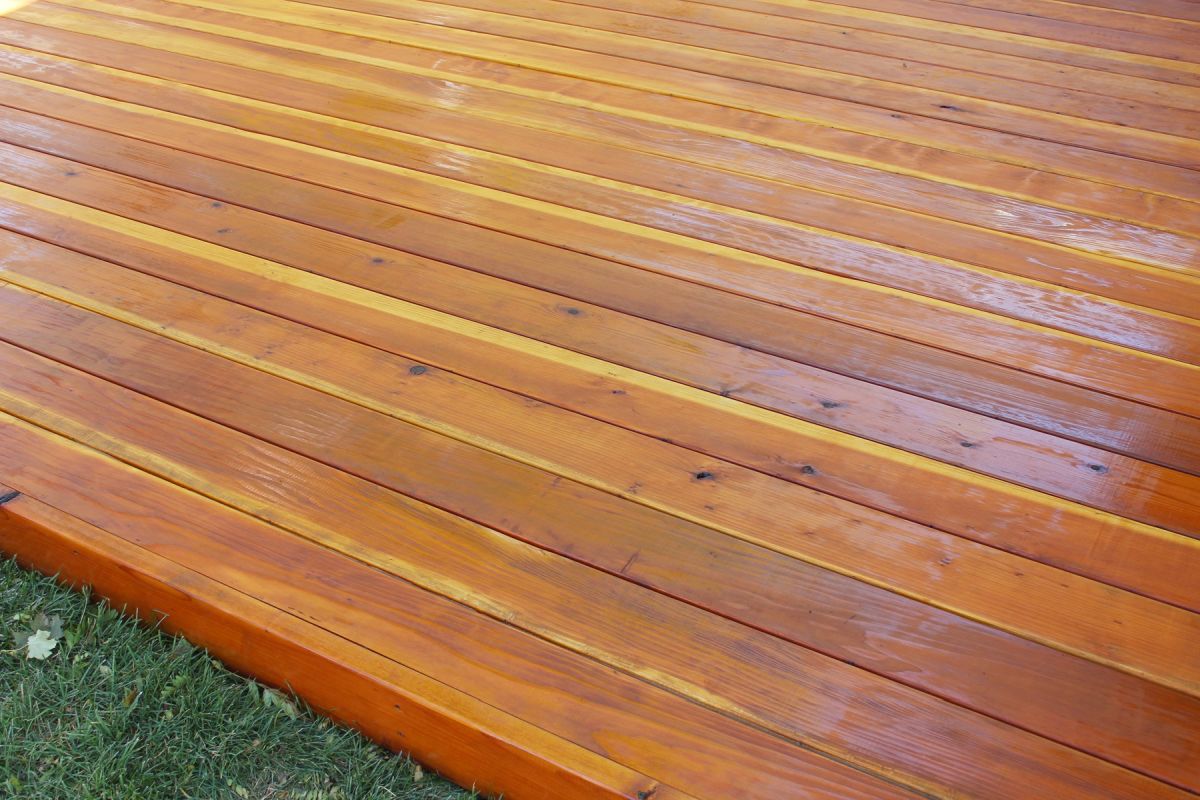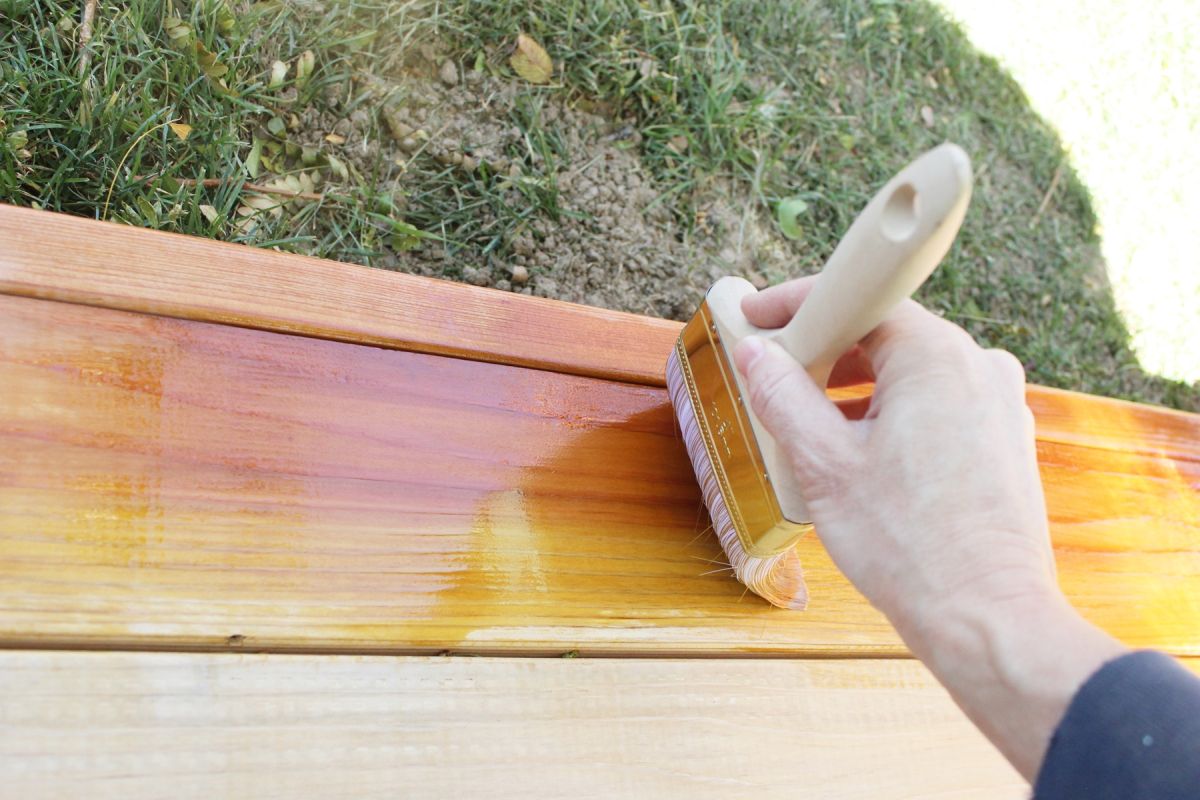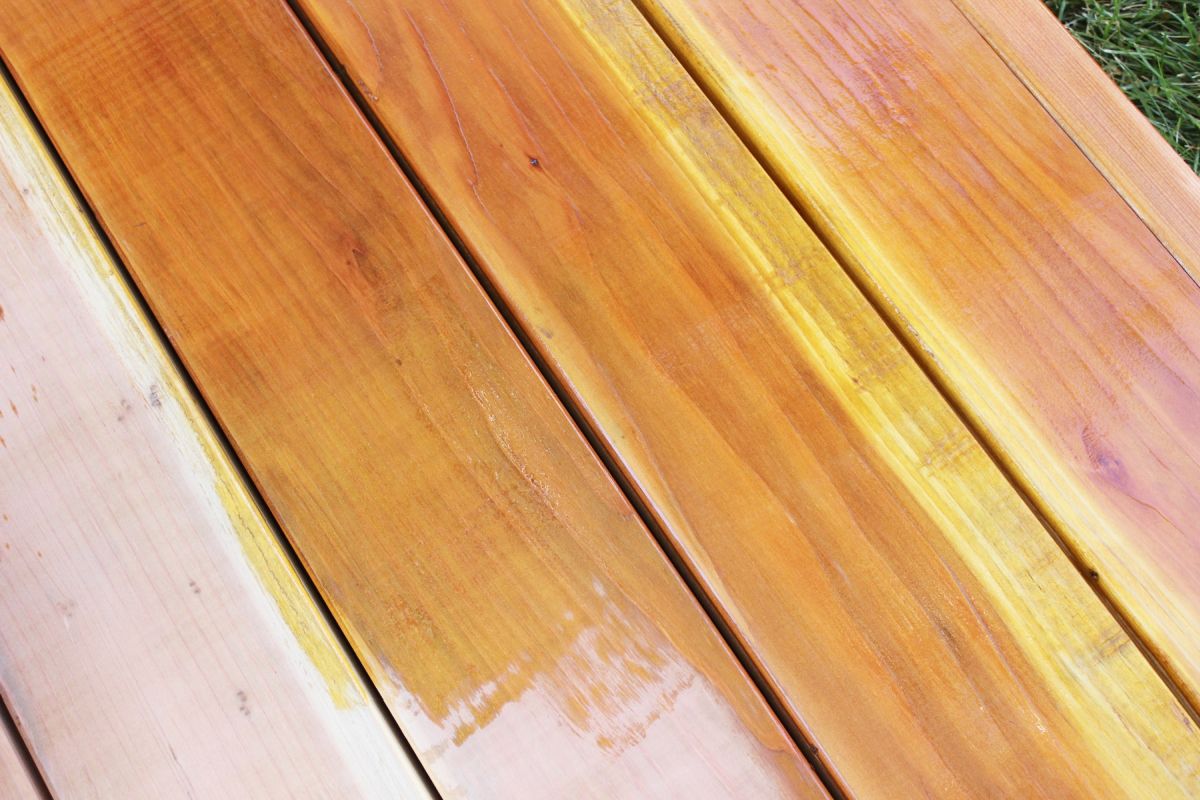Whether your wood deck is brand new or it’s ready for a maintenance staining and sealing, you will want to take the time to stain and seal it properly.
This not only makes the deck more beautiful (an important effect, since it’s a definite value to your home), but it will make the deck last longer and wear better.
In short, doing a good job in staining and sealing a redwood deck is an asset to your yard and to the quality of your life. Just make sure to use the right deck stain and sealer, and have some patience. Here, I’ll show you how!
This photo shows the wet stain on the deck floor. Before we get right into it, you should know the following, if you’re looking to stain and seal brand new wood on your deck.
There are two main schools of thought on the best way to stain a new deck. The first is for the wood to sit, untreated, for 3-12 months to allow the wood and its oils to fully settle and dry, then you sand and seal the wood at that point for best absorption.
The second, and the method this tutorial uses, is for the wood to dry out for at least a week after being installed, then it is sanded and sealed at this point. The reason this second method was selected was due to the fact that, in the climate that this deck has been built, winters are hard – very very cold, snowy, wet, icy, and long.
Because of this, we felt it would be best to protect the wood as much as possible before a winter like that, so we opted to not wait for months. Do your research, then decide which method is best for you. Regardless of your timing, the steps presented in this tutorial will be nearly identical.
Step One: Clean Your Deck
Begin by sweeping your deck floor thoroughly. If it is significantly dirty, wash it. Although, if you saturate the wood with washing it, you’ll need to wait several days/weeks (depending on humidity and temperatures) for the wood to dry.
Step Two: Choosing Sandpaper
Take some 150- or 180-grit sandpaper. This is in between medium and fine sandpaper (120- and 220-grit are more common for wood projects) and does a nice job of not just smoothing the wood but also opening up the wood’s “pores” and preparing it for absorbing stain.
Step Three: Wear Knee Pads
These are technically optional, but kneepads are highly recommended for this project, as you will spend some quality time on your hands and knees. While these foam kneepads do the trick for a few minutes, they quickly become crunched down and provide little padding after just a few minutes.
I would highly recommend spending the $6 more and getting kneepads with a hard shell. These are available at your local hardware store. You’ll be glad you did.
Step Four: Remove Any Rocks and Sticks
Use a screwdriver or another long, slim object to remove any pebbles or sticks that have fallen between the cracks of your deck floor. You want the wood surface to be clean and clear for maximum stain absorption.
Step Five: Sanding Your Deck
Don your kneepads and work gloves (also optional but recommended), grab your sander, and begin sanding the deck floor thoroughly. Always sand with the grain.
Don’t forget to sand the side finish pieces.
If you’re using a palm sander, don’t press down too hard. Let the sander do the work. It’s your job to control its positioning and replace the sandpaper frequently; it’s the sander’s job to do the heavy lifting, so to speak. You may use a little more pressure on splintery parts or down in the cracks, but try not to sand away too much. Your goal is to open up the wood pores here and remove major splinter potential.
Sand not only along the center of your wood boards, but also sand along the gaps, with half your sander on one board and the other half on the other. This will help to ensure an even flatter and more even deck floor.
Work methodically, in sections about 5’-6’ wide, always sanding with the grain. You can see here that it’s relatively easy to tell where you’ve sanded and where you haven’t yet. The sanded wood is much lighter than the wood that has been exposed to the elements, even if just for a week or two.
Continue sanding until the entire deck is done, including the deck surface, the side trim, the railings (if applicable), and any other trim pieces you might have. Anywhere that will be stained at this point needs to be sanded.
Step Six: Clean the Surface
Use a leaf blower (or your broom, if you don’t have a blower) to remove all the sawdust from your deck floor. You’re now ready to stain, as long as rain isn’t in your forecast for at least 48 hours.
Step Seven: Choosing the Right Deck Stain
The best wood deck stain for decks I have found, and recommended highly by my local paint experts, is this Sikkens Proluxe matte stain. It’s a one-step process that involves staining and sealing in one coat. It absorbs beautifully into the wood, and there are several stain tints you can choose. Natural (used in this example) is the lightest one with the least discoloration of the real wood. Although, as you’ll soon see, it still colors the wood but with a saturated, vibrant effect.
Step Seven: Applying Deck Stain
You’ll also want to apply the stain with a 4” brush. Natural fibers are always ideal for application, but the polyester bristles worked well with this stain. And they were much less expensive. They will not last as long as a quality, natural-bristle paintbrush, though. So decide if that’s an investment you’d like to make for your deck.
Stain only the length of one board at a time to avoid overlap. This product really is a one-coat application, so you don’t want your brush to overlap the same point three or four times. The wood will have a hard time absorbing that much stain, and you will probably be unhappy with the end result.
Stain any trim pieces or railings in the same way – one coat, and doing one board or piece at a time.
Be sure you are not staining yourself into a corner. In this example, we started at the outer edge so we could finish the staining process at the deck steps toward the house.
Step Eight: Staining in the Cracks
Apply some stain onto the tip of your brush, and press it into the cracks between boards to stain those as well. Remember that stain is not just for looks – it’s a wood protector, and the sides of the boards need to be protected just like the top does.
You can see in this no-filter photo the difference between the original, unstained redwood and the redwood after this natural Sikkens stain application. It’s much richer and darker.
Use the tip of the bristles along the gap between your redwood boards and side trim piece, also. Anywhere the wood is exposed that you can reach your bristles, that’s where you’ll want to apply stain.
Allow the wet stain to dry completely, at least 48 hours.
It is recommended that you stay off the freshly stained deck for at least 48 hours, and that you keep any furniture off the deck for at least 72 hours.
The stain will appear darker when it is wet; it will lighten slightly as it dries.
I will admit here that I was a little disappointed at this point because, even though we chose the lightest stain, and even though the wood boards were becoming beautifully saturated, they were also more yellow than I wanted. I loved the grey-pink color of our unstained redwood.
This is what the stain looked like directly after application. It’s a little more orange than I had hoped.
But, good news if you find yourself feeling the same way! This unfiltered photo shows what the stain turned into after drying for 48+ hours. It’s not as brash, much subtler, and yet still vibrant and healthy-looking. My favorite aspect is the matte finish, too – nothing shiny about this wood floor, which is a huge plus in my book.
To Sum Up
So, that is how to properly and effectively and efficiently stain and seal your redwood (or any wood) deck. We hope you find this tutorial helpful as you move forward in finishing up a beautiful piece of your property – a wood deck. Enjoy!
How to Stain a Deck
- Choose the type of stain you want. Either Transparent, semi-transparent, or a solid color stain.
- Choose your color. I highly recommend you go with something that matches your home’s exterior.
- Clean existing deck. A pressure washer is best for this, especially if the deck has been sitting for a while. This removes any gunk and film on the surface to open up the pores.
- Apply deck stain in layers, letting each one dry accordingly. You can use a sprayer, or do it by hand with a roller and brush.
- Let dry before using.
FAQ
What temperature is too cold to stain a deck?
Anything less than 32 degrees Fahrenheit is too cold to stain a deck.
Can you stain a deck in the winter?
It’s not recommended, but I guess it depends on where you live. If it’s too cold or wet, the stain will never dry properly.
Do I need to sand my deck before staining?
Yes, if you want it to look its best. Sanding opens the pores and gives something for the stain to adhere to.
The post How to Stain and Seal a Redwood Deck So It Lasts Forever appeared first on Home Decorating Trends - Homedit.





























0 Commentaires